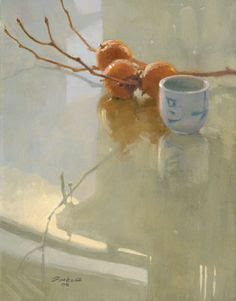

Next is the vase of flowers on a table with drapery.

Then I see flowers with other containers like bowls, cups, teapots, utensils.

There are a lot of glass containers holding flowers.

Teacups everywhere with flowers around, in, and among the teacups. Artists paint flowers on the teacups and place the compositions on flowered surfaces. The pleasantness of a cup of tea and flowers seem to compliment each other.

I wasn't surprised to find all kinds of fruit in flower paintings. The sweetness of fruit goes with the fragrance of flowers. What did surprise me was how few paintings there are of flowers and vegetables. There are some, but not enough to talk about. I assumed artists put everything under the sun in a still life painting.

I found a lot of flowers in front of a window, inside and outside of the house. The play of light was a huge factor.

And then guess what, flowers on chairs?
The next subject is fruit. Fruit is easy to find and set up and with all the shapes and colors it is the subject of many still life paintings.

There is the single fruit study or portrait.

Fruit painted in a group with drapery.

Fruit in a bowl goes together like flowers and vases.

Fruit painted in many different compositions. It was rare to see fruits and vegetables in the same painting.

Fruit placed inside and outside of windows.

Fruit found on chairs and other pieces of furniture.

There are plenty of paintings of food made from fruit.

From fruit to jelly to bread is a frequent subject.

And finally the apple core of which there are many versions.
Paintings using vegetables followed the same ideas as paintings of fruit. The elaborate fruit and vegetable painting of the 16th and 17th centuries aren't as popular in contemporary work. Artists are more interested in simple compositions, portraits of individual vegetables, detail, color, and lighting.

This is a portrait of Romaine lettuce. Different vegetables interested each artist.

Avocados are a popular subject. This is another portrait and cutting it open is like viewing two vegetables because of the seed. You can't cut a head of lettuce open and get the same effect.

Vegetables, like fruit, are set up in a small group. The focus is on movement, color, and light.

Then comes the larger group and sub groups with variations in size and color.

Compositions had other items like bowls that mimic the shape of the vegetable.

Mason jars are popular suggesting canning while adding a transparent quality.

Baskets are used a lot.

Crockery

Squash and pumpkins are in many paintings.

Drapery is often used and most of the paintings I found used shelves for the compositions. Rarely did I see other surfaces like chairs, or corners, etc. Vegetables aren't typically mixed with other foods but instead there might be a variety of the same vegetables. There are far fewer vegetable paintings compared to fruit paintings and artists rarely mix fruit and vegetables in the same work.
The next subject is the egg.

Here again is the portrait.

Eggs in a group

Eggs in a composition next to a bowl.

When eggs are also used in a composition they are usually not the center of interest. They add color, variety of shape, and movement.

The egg shell becomes the portrait.

And the group composition

The inside of the egg is studied often.

This painting shows eggs cooling off in water telling us they have been hard boiled.

Which leads to the hard boiled egg as a meal.

Then there is the pan fried egg for breakfast.

I found a lot of paintings with eggs in a nest. The leads to a whole new group of ideas and how the egg is used.





















